KAROO DREAMING
Adrift in a sea-washed Karoo of succulent and Sperrgebiet
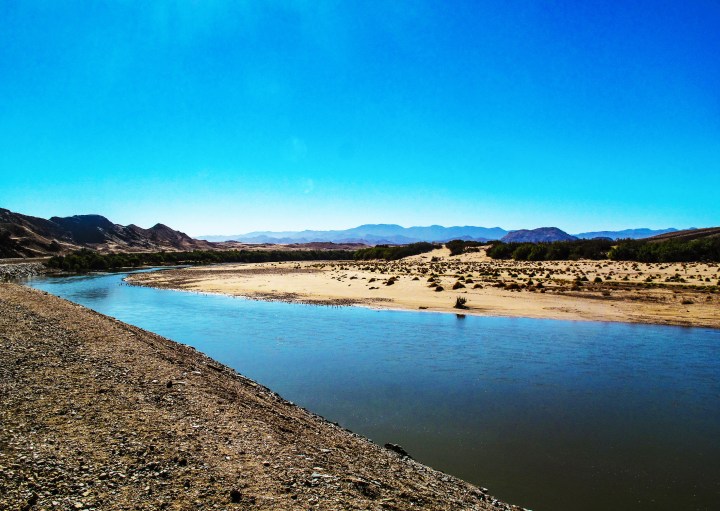
We think of the Karoo as koppie-punctuated Platteland and endless scrubby veld. But there’s a vast swathe of it that hugs the coastline. It even stretches well into the Sperrgebiet and the arid strangeness of southern Namibia. The Karoo I called home. My birthright Karoo.
A wide-eyed boy’s youth in the Karoo was coloured with Tiger’s Eye and amethyst, rumbling dirty yellow Caterpillar trucks and rusty-red lobster. The gem stones were the gravel on the garden path. The lumbering monsters tore away at riverbeds to reveal the diamonds of the desert. The kreef were Sunday lunch. The foaming green sea crashed against the wild, hard shore, inspiring dreams and words, forging in that watery furnace prose that would flow one day long after that time. Is it the life from stone theory: the harder the terrain in which you are formed, the more active the imagination; the less you see of the ordinary, the more you seek the extraordinary? Certainly, the remotest corner of the Karoo we called Oranjemund was nothing like any other town, and that includes every other town in the Karoo.
Yes. The Karoo. It has taken me three years short of my three score and ten for the penny to drop that my home town is in a part of that massive reach of the planet we call Karoo. When we ate our Sunday lobster there, we were devouring the succulent flesh of a creature from those waters that defy you to enter them yet which were entered by my dad’s friend down the road, up 13th Avenue. Never did you see a finer, fatter, bulkier kreef. A Karoo kreef. Succulent crustacean of the Succulent Karoo.
It was at dinner in Sandra Antrobus’s beautiful Cradock home on Saturday night, while sipping glasses of her bright and cheery gazpacho of pineapple, cucumber and chilli, that the conversation turned from small-town municipal woes to the latest travel plans of our friends and resident Karoo experts, Chris Marais and Julienne du Toit. They’re always off somewhere to brew up stories for their rich magazine writing and growing catalogue of Karoo Roads books and they told us they were planning to head to Namibia to explore the Succulent Karoo all the way to Kolmanskop and Lüderitz.
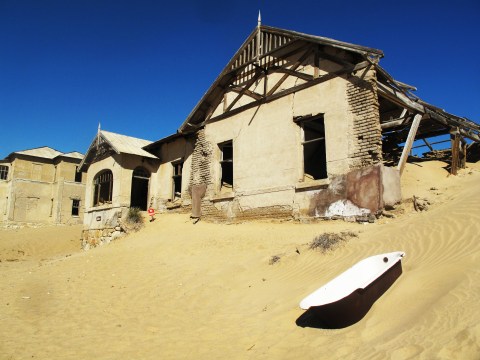
Lehrer’s Haus, Kolmanskop, Namibia. (Photo: Tony Jackman)
Wait, what? When I heard the name Kolmanskop spoken in a sentence that included Karoo I thought I’d misheard. Don’t you mean Kamieskroon, I asked Julie, referring to the mysterious and rocky Namaqualand town we drove through every year when travelling between Oranjemund and the Cape. Nope. Kolmanskop. Kolmanskop, Karoo.
I’ve been to Kolmanskop, Karoo. It’s that sandy wasteland of a Teutonic ghost town just outside Lüderitz, where the Namib dunes crawl in through every door and make themselves comfortable against every wall. Lüderitz, a town where you can eat fat, juicy oysters right off these rocks down there. Where the wind howls icy. Where opulent houses with turned-wood staircases tell cynical tales of men who became rich and lost everything, while others drowned in search of a handful of lustre. Lüderitz, where I went as a two-year-old, with no memories to show for it. Where my big brother went too, so he must have had recollections of its steep hills and grand mansions when he died at six, one Sunday in that Succulent Karoo. There must have been echoes of Kolmanskop’s sand-filled dining rooms and moonscape mystery in that young head as he slipped away from mother, father, sister and brother.
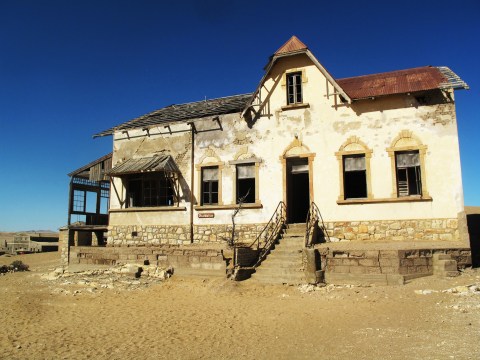
Buchhalter’s Haus, Kolmanskop, Namibia. (Photo: Tony Jackman)
So, between the pineapple and cucumber gazpacho and the oyster-stuffed beef fillet in Sandra’s house, I had to get my already overfilled head around the fact that Kolmanskop is in the Karoo. As is a vast swathe of southern Namibia all the way to Upington. The Richtersveld lies there in its harsh beauty, the kind of terrain where skeletons of the foolhardy lie, bone-white under the relentless sun, never seen by human eye since they fell there in times when glinty-eyed colonisers roamed abroad and stuck their flags in lands foreign and untamed. That Richtersveld is a part of this Karoo of vetplante and kokerbome. And so, Julie added on Monday when they emailed me a link to a Karoo map as proof, is Oranjemund. So. I’m a Karoo boy, born and bred. And suddenly everything makes sense. (Cue stifled chuckles from my friends.)
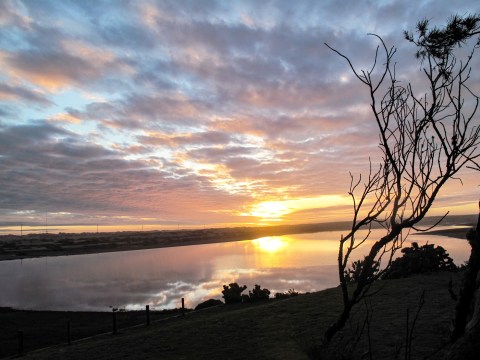
Sunset over the Pink Pan at the mouth of the Orange River near Oranjemund. (Photo: Tony Jackman)
It was in June 2018 that I returned to my home town after 49 years away. A pilgrimage to the town I imagined I hated, to try to get a new understanding of a place with too many bad memories. I wanted to lay ghosts to rest, to try to find my oldest friend or at least know what had happened to him. But from the moment I drove into town I felt nothing but pleasure and happiness. Everything was familiarly unfamiliar. The buildings had shrunk. The little trees in my mind were five storeys high now. We drove out to the Pink Pan, drank wine sitting next to the strange saltwater expanse with its once-pink clubhouse where expat white people sailed their yachts and raced their motorboats with someone on water skis laughing behind them before falling akimbo into the water, laughing nervously.
The better times came back to me in those short days. I never did find Stephen, nobody knew of him. A town that once was all-white had become almost entirely black. It was comfortable suburban and well-off in much the way it had been, smart cars everywhere, mums and dads picking up their kids from the school across the road from our house, but no longer with the (now embarrassing) whiteness of the closed diamond mining town once abrim with expats. The only black people then had been the “house boys” who were enticed from Ovamboland on contracts to work on the mines and clean our houses. I had to live in Cape Town to begin to understand what we’re really all like, who we all are.

My brother’s grave in the cemetery on the edge of the desert outside Oranjemund. Somebody stole the angel. (Photo: Tony Jackman)
All of my childhood kitchen memories had happened in that house on one corner of town near the cemetery where my brother still lies waiting for me. But when I reached high and peered over the garden fence into my old yard, the orchard was gone, the lawns were gone, a giant slab of concrete had filled in the vegetable garden; the only thing that remained was the palm tree my mom had planted when I was five, now as many storeys high above the house. And with every palm frond that fell in all of those long, long years, there lay Phillip, waiting.
But it was when we left Oranjemund again that I truly grasped, for the first time, at quite how extraordinary my childhood turf was. The Sperrgebiet no-man’s land that surrounds the town and stretches far away into Namibia was verboten in the Sixties and for decades that followed. You imagine skull and crossbones signs along the way to the low slung garages out of town where you’d dust down your car for the ride across the Ernest Oppenheimer bridge and on to freedom in Namaqualand and beyond. Danger. Do Not Enter. There Be Dragons.
But now, at the point where you could only turn right onto the bridge, the road continues ahead of you in broad, shiny black tar with the Orange River snaking to your right for 30 km or more before you head north for Aus and then take a left towards Lüderitz, with rare and dying wild Namibian horses for company soon after you leave Aus, arriving in Lüderitz four hours later, yearning for mounds of seafood. Karoo seafood.
The scenery on that four-hour drive is nothing less than jaw-dropping, especially the first hour. I have never been on a more beautiful drive anywhere. In the world. And I was born there. In that Karoo. You feel like you’ve landed on some other planet and the aliens have built a road for you. We saw no other cars on it for the first 45 minutes of the drive to Aus. Outlandish rocky mountainscapes. Blues and purples and every shade of brown and grey. Some towered above you, others rolled away like tumbleweed making their escape. And all of this was there, right there, for the 14 years of my growing years before we moved to Cape Town. And nobody had ever seen most of it. And it’s a part of the Karoo, my Karoo. My birthright.
In the Land of the Thirst King that stretches across 400,000 sq km and several provinces, the Karoo they call Succulent is one of only two arid zone biodiversity hotspots in the world. This and many other nuggets of information you’ll find here and elsewhere on Marais and Du Toit’s Karoo Space website, which is ripe for exploring for those interested in these vast plains. The other arid zone diversity hotspot, they write, is the Horn of Africa. There’s this and much more to absorb as I put the spoon into Cherie Antrobus’s crafty dessert of pink Champagne jelly, vanilla panna cotta and fresh berries, in a sleek margarita glass. She’s lined it up for Valentine’s at their Die Tuishuise and Victoria Manor.
Looking at the Karoo map on the Karoo Space website now, it jumps out at me that I started life in one of the westernmost towns in the Karoo and now live as far east as the Karoo reaches. From Oranjemund to Cradock, a journey linking lives and stories.
But first, we planned to do the journey in reverse. To get there back in 2018 we have to drive from Cradock via Graaff-Reinet to Murraysburg and on to Victoria West, then across via Carnarvon, Williston and Calvinia in the Hantam Karoo to Vanrhynsdorp, the home terrain of Land of the Thirst King author Willem Steenkamp, one of my early Karoo and newspaper heroes. My old friend Willem Branca, his nephew, still farms there and makes his extraordinary artworks. (Land of the Thirst King was an excellent TV documentary series in 1979 too, hosted by Willem Steenkamp himself.)
From Vanrhynsdorp, in the southern reaches of this Succulent Karoo, where we sometimes overnighted in the local hotel in the Sixties, as typical an old Karoo hotel as it gets, you endure beating sun as the terrain harshens by the minute, until you bypass the timeless dullness of Bitterfontein and Garies and finally come upon Kamieskroon, where less happens now than happened even 50 years ago, and on to Springbok, where your eyes open wide at what Chris Marais has called Boomtown, and you can see why. When I was a kid there wasn’t much to it; a rocky town in a stony landscape. Since then it has sprawled in every direction, but detour into what used to be the main drag through town and there they are, the Springbok Hotel to one side, the Masonic to the other. We spent a night in the Masonic on that trip to my boyhood; my mind flipped back in time, and there I was, just seven, looking out of the bedroom window at the strangeness of a kokerboom across the road, and there I was at nine in 1964, dad’s off-white Cortina GT with the red flash parked outside. I could see myself, smell the poaching fish, taste the lamb chops, drool at the thought of the fruit salad and ice cream to come.
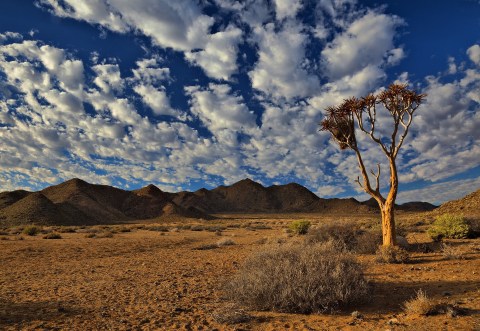
Kokerboom in the Richtersveld. (Photo: Vincentvanoosten on Pixabay)
Soon after leaving Springbok and onwards towards the Vioolsdrift entry point to southern Namibia, you find Steinkopf, back then a tiny settlement stuck in the lee of a koppie, now a town sprawling across the road. Here you turn left towards the Anenous Pass with its rust-dead car wrecks and the moody avarice of Port Nolloth, where the Scotia Inn entices you with Karoo seafood or you find a ramshackle beach hut for fish and prawns. Finally, the now tarred stretch of 80 km or so past giant mine dumps and on to the Ernest Oppenheimer Bridge and boyhood dreams of a life far away, now returned to, sought out by the older man with long memory and a keen ear for nostalgia.
And dad, there he is, walking back down 13th Avenue with a sackful of kreef for us to braai for supper. And mom, look, there she is, with her apron on in the kitchen, beating the batter for a vanilla pound cake. And me at her side, but with one eye out of the window at the long road ahead and wherever it might lead. DM/TGIFood
Tony Jackman is Galliova Food Champion 2021. His book, foodSTUFF, is available in the DM Shop. Buy it here.
Follow Tony Jackman on Instagram @tony_jackman_cooks. Share your versions of his recipes with him on Instagram and he’ll see them and respond.
SUBSCRIBE to TGIFood here. Also visit the TGIFood platform, a repository of all of our food writing.





 Become an Insider
Become an Insider
Loved this article. It takes me back almost 50 years when I was an exploration geologist in that world.
memories of sitting outside the Bitterfontein Post office waiting for them to put through a call to my office in Johannesburg. The VanRhynsdorp Hotel and the early morning wake up calls.
What exquisite writing Tony Jackman. I can feel the dust, smell the kreef, stroke the kokerboom. I love that part of the world.
Fascinating read… and so evocative. And those starkly beautiful “Karoo” images.
Dear Tony, this rich, descriptive, very personal writing of yours does not deserve to be relegated over time to an online archive that might only be traceable using an internet search engine. Please consider bundling these priceless articles into a book, or, if this is not feasible, maybe Julienne and Chris could consider including these wonderful insights and memories from you as a guest contributor, word for word, in their future publications on the Karoo. Thanks so much for sharing these writings, they are as delicious as the recipes we have tried so far from foodSTUFF.
Thank you Tony for a taste of your lyrical writing once again… a mish-mash of foodie gems, childhood memories, friendships, the smells and sights and taste of the land and the best the Karoo has to offer!
Not being born and bred in the Karoo, I cannot claim it as my own, but if we have a “soul country” then the Karoo is mine.. and how awesome that it stretches all the way into southern Namibia, one of my favourite places on this earth now forms part of this “soul country” of mine!
Poignant. Beautifully measured writing. Thank you.
Beautiful and poignant at the same time.
Excellent, thank you!
It takes me back to the mid 1970s when I travelled through the beautifully harsh landscape.
It’s a place where you can let your soul hangout and your mind wonder all over this arid landscape.